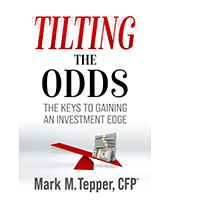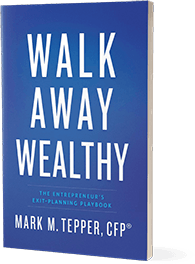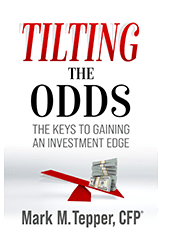Different Year, Same Stuff
I’ll always remember the stock market in 2000. That’s the first year I was a portfolio manager, and what a year it was. At the beginning of the year, I thought the valuations of tech, media, and telecom stocks made no sense whatsoever. At the time, our rule was that we had to have at least one stock from every sector, so I had my mandatory pick in Creative Labs, a computer sound card maker that had little growth prospects and was priced as such. As for the rest of tech, I didn’t want any of it.
In retrospect, that was a great idea, right? Sure, but there was a lot of abuse between January 1st and March 10th, both internally and externally, as tech continued to soar. Even at the ripe old age of 24, I was pretty calm and thoughtful. I couldn’t be shaken from the belief that these stock valuations just made no sense. The darkest hour was probably when our largest client, who had recently hired us, turned around and fired us, saying we could never make the losses back.
As it happens, we made the losses back, and more, beating the S&P 500 by a mile, that year. Our lone tech pick did lose money, by the way, just not as much as most tech stocks. Meanwhile, those who believed tech was going to change the world suffered through years of value outperformance. Cisco, which was the king of tech stocks at the time, still hasn’t made new highs from that time.

You can take a lot of lessons out of 2000, but the basic one I’d consider here is that narrative follows price. We all know, now, that of course Pets.com didn’t deserve its valuation back then, but that’s not what most people believed at the time. The market is not some genius calculator. Dump a lot of money in it, like we did with Y2K, and it can do some pretty dumb things. Does that idea ring a bell?
Moving forward in time, during 2006, I first saw warning signs of financial trouble. I thought it was too far away to cause major issues, but the warning signs kept coming up. As 2007 wore on, the problems piled up, and we started selling our financial stocks. By late summer, we were completely out of the financial space, as I thought the risks were too high to be involved.
Like in 2000, our early caution caused underperformance, and despite solidly beating the market since 2000, we got fired by some clients who didn’t see the risks but did see the missed rewards. 2007 turned into 2008, which turned into the Great Recession. Until recently, the Great Recession saw the biggest spate of bank failures in US history. It took a long time for concerns to develop into downside, and there were at least two strong rallies during that period that must have sucked people in, but clients who stuck around seemed pretty happy they avoided a good chunk of the damage.

Lessons learned? The market isn’t always right. Also, it’s hard to say the problem is solved before the root causes are dealt with. The rallies happened after significant events, like the failure of Bear Stearns. People thought the bad news was done with, and they were in a hurry to take advantage of the opportunities. That didn’t work out for them, as there was still a lot of downside ahead.
I’ll bet you’ve guessed that I’m comparing those periods to now. Yep. Once again, unending liquidity (now from the Treasury and RRP) is distorting markets. I wouldn’t mind so much if it wasn’t so clear that the trend is going to end. The Treasury could run out of money in as little as nine days, then that spigot gets cut off, and the RRP is just fast money chasing perceived opportunity. That can, and very likely will, turn on a dime. Echoes of 2000.
We’ve also had massive bank failures and the economy hasn’t even made a sighting on the recession that’s coming. Lots of finance, such as real estate, takes quite a long time to play out, like we saw in the Great Recession. From the first sightings of problems in 2006 to the government panic in 2009 was quite a long time. By the time it was over, most investors were beaten and bloodied. Risk appetite was in the basement.

Look at the chart above. That’s not what’s going on now, it’s from 2000, but I think there are real similarities. This time around, the market peaked at the start of 2022, and I’d expect we’re hitting a secondary, lower peak now, based on flows and options positioning. In 2000, from that secondary peak, we started going down for real. The broad market suffered some, but it took the Nasdaq 100 about 15 years to get back to even from the previous peak.
That’s my basic worry for people piling into the latest AI darlings. I don’t think people understand, or care about, the fundamental implications needed to justify buying a $700B+ company at 29x sales. Not earnings, mind you, but sales. Right now, I’m sure they’re happy with their choice, as a number of those stocks have doubled or more, YTD. Ultimately, though, an investment isn’t a profit until you sell it, and when we run out of momentum or FOMO investors, who’s going to buy it from them? At this point, fundamental investors are far lower. That gap to the next marginal buyer may hurt.

The chart above, in my mind, is a pretty stylized presentation of reality, but doesn’t it seem reasonable to say we’re most likely in some form of the Complacency phase? That doesn’t mean there can’t be opportunity for the rest of the year. For example, we could go down on debt ceiling worries, then back up on some form of resolution. However, the longer-term upside seems pretty thin, with a looming recession. A slowing economy and inflation have had me pretty cautious, as that’s where losses can most easily happen. I’m happy to take reasonable risks, but in general, the most important thing to do here is not lose money.
The last thing that should be said is I really have no idea if this period will be as bad as the two major bear markets talked about above. Maybe we can get through this relatively gracefully. Maybe inflation can fairly steadily get down to that 2% level without causing major damage to the economy. I honestly hope that happens, but it concerns me how little people currently seem to be worried about anything at all. That implies stocks are optimistically priced, as there’s no ‘worry discount’ in there. It doesn’t pay to spend much time worrying about distant possibilities, as the market rarely cares about them. However, an environment with a number of potential fairly negative future catalysts and impressive complacency is something to take note of.
 Enter your information below, and we will email you our new eBook, Tilting the Odds
Enter your information below, and we will email you our new eBook, Tilting the Odds




